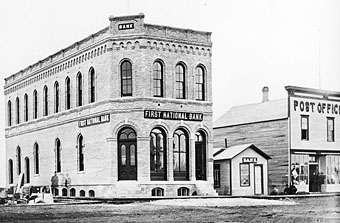Federal Buildings and Post Offices

In 1871, Jack Lowell, Henry Back, and G.J. Kenney petitioned the government to establish a post office. Some weeks later, Kenney received his commission as postmaster "at the crossing of the Northern Pacific at the Red River in Pembina County." (At the time, Pembina County of Dakota Territory included all of what is now North Dakota.)
At the time of Kenney's commission, the crossing point of the railroad across the river had not been decided. Kenney went to Holy Cross every few weeks and picked up the mail addressed to Centralia, as the crossing point was first called. Kenney would carry the mail with him until he met the men to whom it was addressed.
When the railroad crossing was finally located, Kenney erected a 10x18 frame shanty covered with tar paper on thewest side of the Red River where the Northern Pacific bridge was built. The next spring, Kenney moved the building to approximately where Broadway crosses NP Avenue. In 1873, Kenney moved the Post Office again, this time to a Mr. Maddock's building on Front street. The building was located on Front Street just west of Broadway and is pictured in the top right image. Photograph from the State Historical Society of North Dakota Museum Collection C05550. (The information above came from Kenney's recollections published in the Sunday Argus, July 5, 1896)

In December 1887, in preparation for mail delivery, Fargo set up the present street and house numbering system. Some Fargo residents and businesses were opposed to mail delivery. Other residents and businesses were reluctant to put numbers on their buildings. In frustration, the Fargo city auditor issued a statement on December 9, 1887 that "I shall start a man tomorrow with a paint pot to number buildings. He will start on Broadway and number all buildings not already numbered, regardless of the kickers. During the cold weather, he may not be able to do a very good job with the brush and may have to use a stencil. We shall not pay much attention to aesthetic considerations."
Fargo's first mail carriers (Gilbert C. Grafton, Harry T. Hance, and John M. Johnson) began their appointed rounds on January 2, 1888. W.J. Judd was Fargo postmaster at the time. He told the Argus on January 7, 1888, that "the carriers are doing nicely, and while I am losing money from box rental, I hope it will help the city."
A new Post Office and Federal Building was designed by the Hancock Brothers and built in the 1890s (pictured right). It stood at the northwest corner of Roberts Street and First Avenue North. Initially it had a simulated bell tower but that was removed when a third floor was added about 1905 (see below).


A new Post Office and Federal Building was built in about 1930 on the northwest corner of Roberts Street and Second Avenue North (shown above right). That building served as Post Office, Federal courthouse, and Federal building until a new Post Office was built in 1970.
After the post office, moved the old building continued to serve its other Federal tenants until 1998, when a new $15 million, four-story addition was added west of the existing building. The two ends of the building (shown below right) are connected by a glass atrium. The new part of the building houses the U.S. District and bankruptcy courts and the U.S. Marshall Service. The older section was remodeled and houses the U.S. Attorney's office and other court-related agencies.
The resulting Quentin N. Burdick United States Courthouse was dedicated at 10 AM on July 29, 1998, completing three years of construction.
Presiding at the dedicatin were Fargo Mayor Bruce Furness and U.S. Distrcit Judge Rodney Webb (one of the major proponents of the new building). The Burdick family donated a bronze bust of the building's namesake, created by Paul Granlund (a sculptor from St.Peter, Minnesota).


A new Post Office was built in 1970. Shown above, the Post Office is located on the northwest corner of Roberts Street and Second Avenue north. The building was dedicated on Friday, June 26, 1970, at 10am. A 30 minute band concert preceded the event. Among the dignitaries attending the dedication were Governor William L. Guy, Fargo Mayor Herschel Lashkowitz, Senators Milton R. Young and Quentin M. Burdick, and Representatives Thomas Kleppe and Mark Andrews.

